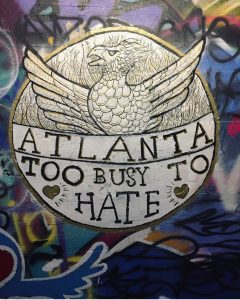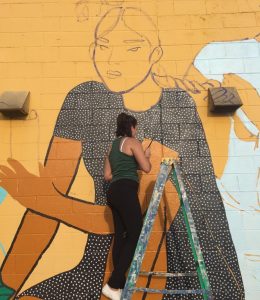Before this semester I looked at murals the way most 18-year-olds with social media do: a great background to take a photo. I never stopped to think about the artist behind the piece, and very rarely did I acknowledge the significance of how that street art could impact the community. Though as we close the semester, my work in Mexican Moralism and the Rise of Public Art has shown me that muralism acts as a change agent and one of the loudest voices leading a community.
During my second week at Agnes Scott my class and I visited the Krog Street Tunnel where Peter Ferrari from the Forward Warriors Project presented Cabbagetown as a canvas for influence. Plastered along the walls of Krog Street were messages in which artist used their skills to lead the community to love in a time ravaged with hatred. “Atlanta too busy to hate” jumped out to me from a sea of drawings and tags responding to the recent violent protest that occurred in Charlottesville that August. It was the first time I saw street art as something more than edgy or trending. From this experience I came to a realization that influential art is not limited to the walls of a gallery or specific style of painting. Street artists act as leaders by engaging in present challenges in their communities, and advocating for change through their visual influence using concrete as their canvas.
Credit: “Mural at Krog Street Tunnel” by Angelica Martini is licensed under CC BY SA 3.0
In October I had the pleasure of working with artist Dianna Settle as a volunteer for Living Walls Atlanta. Dianna is a Vietnamese American artist based in Atlanta whose work is representative of her views of identity politics. While helping paint this mural, Dianna explained to me that seeing yourself in the place you grow up is significant in building your identity. To Dianna this meant painting a mirror of cultural diversity that is present in Buford Highway. The objective of her mural was to better connect the community to the space they inhabit.
Credit: “Painting with Forward Warrior” held by Angelica Martini is licensed under CC BY SA 3.0
Both Living Walls and Forward Warrior have shown me that being a leader in your community means being an active and politically aware member of that community. Both projects are a part of a muralist legacy that relates back to the work of Los Tres Grandes. Diego Rivera, José Clemente Orozco and David Alfaro Siqueiros, though very different artists, used their murals as the voice of the working class under the post Mexican Revolutionary government. Diego Rivera once said, “Art is like ham, it nourishes people.” The work Los Tres Grandes executed intended to nourish the predominantly illiterate population of Mexico during the 1920s with understanding of their struggle, and movement towards change.
I believe that one of the greatest qualities a leader can possess is understanding the position of those that follow them. From the Mexican Muralist Movement to contemporary street artist, I have seen that engagement allows these leaders to impact their community on a personal level. Throughout the events I have participated in this semester I see that leading is being present, enthusiastic, and passionate. I hope to carry these qualities into my second semester and develop them for leadership positions beyond college.
